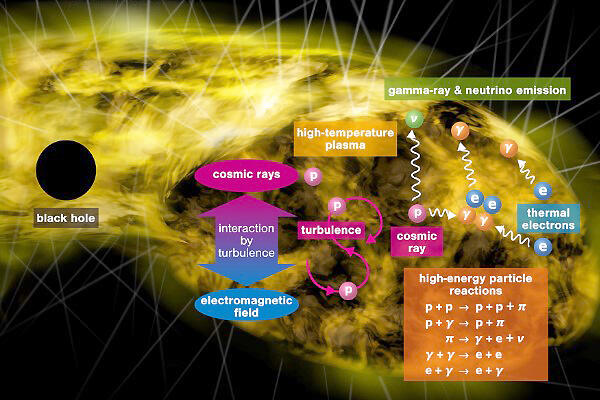Although the universe is filled with energetic particles, such as neutrinos and gamma rays, their origins and the mechanisms of their generation are not yet well understood. A research team led by Shigeo S. Kimura, a researcher at the Frontier Research Institute for Interdisciplinary Sciences, Tohoku University, has recently proposed a theory that mellow supermassive black holes could be the origin of these cosmic particles. It is believed that there is a supermassive black hole in the center of almost every galaxy. When the interstellar gas in the galaxy falls into a black hole, it emits electromagnetic waves of various wavelengths, and the acceleration of protons leads to the release of neutrinos.
The research team theoretically evaluated the state of matter around a low accretion supermassive black hole using X-ray observation data from a small amount of depressed gas. It was clarified that electrons, when heated to 10 billion °C, efficiently emit gamma rays of approximately 1 million eV. It was shown that high energy neutrinos are also efficiently generated in such conditions, and the radiated gamma rays and neutrinos can naturally reproduce the observed data on the Earth.
The theory proposed in this study suggests high-temperature electrons to be the origin of gamma-rays. Previous theories mainly considered that non-thermal cosmic electrons are accelerated to high-energy states and undergo radionuclide decay.
Based on results of the present study, the researchers have proposed for the first time that high temperature plasma is the origin of cosmic gamma‐ray background radiation. The theory suggests that the switching of energy forms from the thermal universe to the non-thermal one differs from previous expectations. Dr. Kimura stated that, "In the future, developments in observation and experimental technology will advance the understanding of black hole objects that were previously difficult to observe. This is expected to clarify the origin of high-energy particles from space. In particular, planned gamma-ray satellites and large-scale neutrino experiments are the key to testing this hypothesis."

This article has been translated by JST with permission from The Science News Ltd.(https://sci-news.co.jp/). Unauthorized reproduction of the article and photographs is prohibited.




